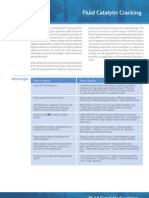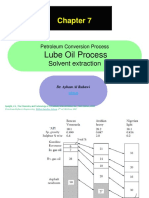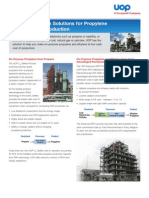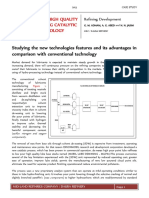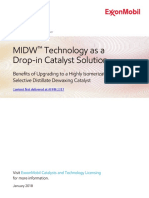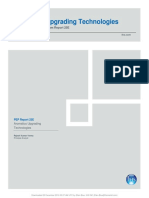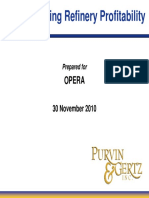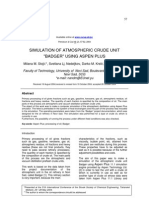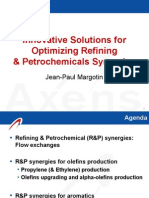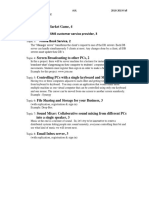Valero Emerson Blending
Valero Emerson Blending
Uploaded by
Gerrard ArchuletaCopyright:
Available Formats
Valero Emerson Blending
Valero Emerson Blending
Uploaded by
Gerrard ArchuletaCopyright
Available Formats
Share this document
Did you find this document useful?
Is this content inappropriate?
Copyright:
Available Formats
Valero Emerson Blending
Valero Emerson Blending
Uploaded by
Gerrard ArchuletaCopyright:
Available Formats
Originally appeared in:
June 2016, pgs 45-47.
Used with permission.
Special Report Process/Plant Optimization
W. SCRIVEN and A. MARTIN, Valero Energy Corp.,
Pembroke refinery, Wales; and D. SEIVER, Valero
Energy Corp., Houston, Texas
Utilize an optimizer to blend gasoline directly to ships
A new control system and single-blend optimization system This method required the refinery to maintain considerable
make it possible to blend gasoline directly into tanker ships for tank capacity. Tanks are costly, they require maintenance, and
delivery, rather than only into tanks, thereby saving millions in safety and environmental regulations require instrumentation
capital and reducing product giveaway. to prevent leaking, overfilling, etc. Additionally, the tanks are
The 550-acre Pembroke refinery (FIG. 1) has been operating never completely emptied, which represents essentially frozen
since 1964. In addition to its terminal equipment, the facility has assets—inventory that is never shipped but stays on the books
eight berths for ships and more than 100 tanks of various sizes and is taxed every year. The average tank inventory is generally
with total capacity of 10.5 MMbbl. The complex can facilitate 10 considered to be captured cashflow that is not realizable until
crude ships per month. the tank is emptied or the assets sold.
Touchups, even if they result in shipped product that meets
Gasoline blending system. The refinery’s gasoline blending specifications exactly, are also expensive. They result in poor
system has a capacity of 2,000 m3/hr. The blending situation utilization of both equipment and human assets; they put an
for the refinery is very complex, if for no other reason than the
number of different components and grades of finished gasoline
it produces. The produced gasoline must meet the different
specifications for multiple markets (US, Europe, etc.). Most
outgoing products go by tanker ship, with a smaller amount
going by road tanker.
Refining is a highly competitive commodity industry that
yields fungible products with low margins, and a refinery’s
blending operation can be considered its “cash register.” This is
the last chance to optimize the final saleable product, as well as the
final opportunity to achieve as close to product specifications as
possible. Any giveaway at blending—caused by shipping better-
than-grade specification product—is lost revenue and cancels
out the benefits from optimizing upstream unit process areas.
As illustrated in FIG. 2, a small reduction in giveaway yields
impressive results; for a typical refinery, blend optimization FIG. 1. The Pembroke refinery in Wales has eight berths for ships and
could deliver millions of dollars per year in bottom-line savings. more than 100 tanks of various sizes with total capacity of 10.5 MMbbl.
It is estimated that the industry-wide total costs of Reid vapor
pressure (RVP) and octane giveaway exceed $2 B/yr in the US Crude Unfinished/components Product blends Finished product
and several times that total worldwide. Capturing even a fraction
of that opportunity can offer a strategic refining advantage. 1.2
Refinery margin, price factor × crude
Optimum
blending $$$$
Traditional gasoline blending methods. The original
blending system in the Pembroke refinery combined set volumes 1.1
of multiple gasoline component streams in a header to produce Crude mixing
penalty Suboptimum
each batch of finished gasoline, which was then routed into a set blending
of tanks. A sample was taken to the laboratory for analysis. After 1.0
the results were determined, the mixture would be “touched up”
to meet requirements, if necessary, and a certificate of quality/
Crude receiving Process units Blending Product shipping
analysis would be issued. Often, the touchup of an off-spec offsites
blend caused giveaway by adding a buffer to avoid carrying out
a second touchup. When the ship arrived, the blended gasoline FIG. 2. Capturing even a fraction of blend optimization opportunity
can present a strategic refining advantage.
would be pumped aboard from multiple tanks.
HYDROCARBON PROCESSING JUNE 2016
Process/Plant Optimization
extra load/cost on the lab due to the retesting required; and, flows, etc., and calculates a recipe that is optimal for the blend
if there is a problem and the blend testing comes out off-spec, at any given moment to meet the optimization objectives. The
then shipments are delayed and incur potential demurrage optimized recipe from the BOSS is then fed to the regulatory
charges for holding up the ship. software package, which calculates the appropriate flow setpoints
In 2011, a study was undertaken to find ways to improve for the individual blend component control loops. For example,
the blending process: a project to replace the existing blending it takes a 41% alkylate recipe and translates that into a setpoint for
arrangement with one that would allow the blending of gasoline the alkylate flow control loop. It performs other regulatory level
directly to ship rather than solely to tankage. Such a system had functions as well, such as starting and stopping pumps, etc. FIG. 3
the potential to save millions of dollars each year by reducing shows schematically how the different parts fit together.
the number of tanks needed in gasoline service, as well as satisfy
the key performance indicators of lower average blend giveaway Consistent data helps obtain operator acceptance.
and the minimization of touchup blends. A critical success factor of the new system is the presentation of
consistent views to the operator. The design and implementation
Upgrading the blending system. The refinery was already of such a system must revolve around a single-screen integrated
scheduled for a control system update, which would ultimately approach to minimize the different operator system interactions.
include replacing the existing, and obsolete, distributed control All the blend regulatory controls—start/stop, routes, ramp,
system (DCS). The gasoline blending optimization project ratio and pacing—are handled in the DCS via commands from
was approved, and the project teams realized that it would the blend optimizer, akin to a master/slave control relationship.
integrate well with a new DCS system upgrade in the blending The operator displays are kept to a minimum and are integrated
and shipping areas. with the DCS graphic, which helps considerably in obtaining
Each batch of finished gasoline is made by simultaneously operator acceptance of the new system.
blending up to 21 different component streams in a header— The optimizer screen is the interface that the operators use to
typically 10 or fewer streams at a time, with mid-blend pump and start and monitor the blends. This screen is typically provided on
tank changes. Each component has a flowmeter, a proportional a separate interface screen, but using RDP from the DCS made it
integral derivative (PID) controller and a target ratio set by the possible to display this screen within the DCS system, simplifying it
control system. A set of online analyzers provide feedback for for the operators and demonstrating the “single-screen integrated”
optimization and certification using state-of-the-art redundant approach the project team and operators wanted.
sample compositors. The system can achieve up to 20 quality
limits simultaneously, although the number is usually closer to Challenges encountered. As expected, designing and
five. The output of the blending system (finished gasoline) can implementing the new system was not without its challenges,
go into tanks or directly onto a ship. many of which coincided with systems not always being
The blend optimization system used at Pembroke is available when needed. At the front-end engineering and design
comprised of a highly standardized mix of both hardware and (FEED) phase, there were gaps in the system knowledge, which
software components. The system is built of several layers: At is often the case in projects where very old systems are in place
the bottom (just above the field devices) is the DCS; on top and little or no good documentation still exists.
of the DCS is an advanced regulatory software package, which To in-line blend directly to a ship, a composite sampler that can
handles the ratio control functions. Above this layer is a blend take samples at required rates for the size of the blend and provide
optimization supervisory system (BOSS) software package. a composite of exactly what went onto the ship (it is very difficult
Sitting at the top of the pyramid, it processes data from analyzers, to test the separate tanks on a ship) is required. The sample
compositor takes a cross-section of the
Refinery blending unit DCS Blend optimizer final product exiting the blend header. This
SBO blend SBO blend
can be tested in the lab and a certificate of
FT
Tank AE M recipe ratio property M
quality/analysis can be produced.
component A
M control control These custom-built, redundant-
sample compositors, which are a proxy
Multi-blend
FT planning M for the blend tender going to the final
Tank AE
M
M software destination (i.e. ship), must be very
component B robust and very accurate. The reliability
M of such a system is critical, as any failure
Pipeline would result in uncertain specifications of
FT
M VGBOP the gasoline product loaded onto the ship.
Tank AE
M Redundant FTIR and M
component C vapor pressure online Note: Backup procedures are in place that
field analyzers allow for additional testing and sample
FT collection, should the compositors fail
M
Tank AE
M Multi-blend PT
M Finished to avoid any off-spec loading to the ship.
component D planning product tank
Coriolis software Establishing the reliability of this system
meter was a minor challenge, but in the end it
proved to be extraordinarily valuable to
FIG. 3. A schematic drawing of the various parts that comprise a blend optimization system.
the overall success of the project.
HYDROCARBON PROCESSING JUNE 2016
Process/Plant Optimization
Another challenge came from the limited time available
for the factory acceptance test (FAT). There were delays in
getting all parts of the project approved due to the compressed
timescales needed to take advantage of the earlier-than-planned
DCS upgrade. Consequently, this reduced the time available for
the FAT. To make things worse, the system was being migrated
from one that had been in place for decades. Many pages of
leftover custom code needed to be identified and stripped out
before the new system could be fully programmed.
Hardware problems also had to be overcome.
Communications with some of the antiquated and poorly
documented serial devices in the facility proved difficult.
Some of the flowmeters on the blend header had little or FIG. 4. A blend analyzer screen shows an overview of all running
no parts availability and documentation was sparse, making pumps, control valve positions and flowrates, providing an expedited
installation and tuning impossible. It was decided to replace view of gasoline blend property values.
a number of these instruments on the blender to improve
long-term reliability. Custom modifications to the DCS input It is much easier to see the sequential function charts
modules were installed to integrate these into the DCS so that executing the sequencing of the startup and shutdown with the
future updates, tuning and maintenance would be simplified new displays; if there is a problem, the operators can detect its
and could be carried out in-house. origins and how to correct it. It is also useful when calibrating new
turbine meters, making it possible to see exactly what K-factors
Results. The new system was first used to produce optimized have been installed and the changes needed for calibration.
blends to tankage, and within weeks optimized blends were Additional benefits may be considered, such as the reduction
being successfully loaded directly to ship in parallel to loading of approximately 70 Mbbl of gasoline, which reduces the onsite
from existing tanks. Several months later, the site completed its storage of hazardous materials, the need for operators and
first 100% full blend to ship, a parcel of 46 Mm3 taking over 50 maintenance to work around a commissioned tank, and the
hours for an export cargo. All direct-to-ship blends tested to spec environmental risks of hazardous material storage. Overall, the
on shipping, and again when received at their final destination. project team identified process improvement opportunities,
As discussed, one of the eight gasoline storage tanks (used delivered one-time capital benefits of several million dollars,
previously for final product containment prior to ship loading) and provided a sustainable blending optimization solution that
was removed from gasoline blending service and reallocated has already contributed significant ongoing annual operational
to another component system. This move freed up several savings and is expected to continue for many years forward.
million dollars of gasoline inventory, mitigating required
upgrades and allowing tank scheduling decisions to be made WILL SCRIVEN is a senior control system specialist for the
on decommissioning or changing of service. Far fewer reblends blending and shipping area at Valero Energy Corp.’s
Pembroke refinery. He has six years of experience in the
are seen, and the blends are closer to spec than before, which control systems department. Prior to this role, Mr. Scriven
reduces giveaway costs. completed an apprenticeship in instrumentation and was
To maximize the system and manage assets effectively, a an instrument technician at the site for two years.
multi-discipline team was developed to monitor, maintain
and improve the gasoline blender and its peripheral systems. ANDREW MARTIN is a senior process engineer with Valero
A series of key performance indicators (KPIs) was set up, Energy Corp. He has five years of experience as an engineer
in the Pembroke refinery as part of the process engineering
and the site began monthly tracking of the optimizer savings and advanced control teams. He also spent three years in the
and performance. To date, the results have shown excellent power generation sector, where he was a performance and
performance, and the new system provides more flexibility commercial engineer as part of the operation and
for product planning and scheduling. The site has been able commissioning team for the Pembroke combined-cycle gas
turbine (CCGT) power station. Mr. Martin has developed advanced control
to maximize the value of the gasoline blender by reducing the applications for steam and utility plants and led process optimization for
time it takes to fill, test, certify and load multiple tanks to ship, gasoline blender and CCGT power station operation. He has experience in power
resulting in increased system throughput and, at the same time, station commissioning, energy markets and multiple DCS platforms. He holds
an MS degree in chemical engineering from Cambridge University, where he
minimizing the cost of finished product by blending the least attended Queens’ College.
costly components required to make on-spec gasoline.
System troubleshooting has also become much easier. For DAVID S. SEIVER is the director of blending APC technology
example, the old system had four graphics for the operators for Valero Energy Corp., managing the rollout of the
to monitor pumps and controllers, whereas the new system company’s single-blend optimization (SBO) program at its
refineries. Mr. Seiver has over 25 years of experience in the
condensed that down to one graphic. Operators can now petrochemical and industrial gas industries. Prior to coming
quickly view the blend header graphics, which are more of a to Valero, he specialized in gasoline and diesel SBO for
graphical representation of the system, and provide an overview ConocoPhillips at its Wood River refinery, as well as provided
technical blending assistance to other sites. He has extensive expertise in APC,
of all running pumps, control valve positions and flowrates. A SBO and NIR modeling, and has two US patents in the APC field and one US
blend analyzer screen (FIG. 4) provides an expedited way of patent for gasoline optimization. Mr. Seiver holds an MS degree in chemical
checking gasoline blend property value. engineering from the University of Houston.
Electronic permissions to Emerson Process Management from Hydrocarbon Processing
June © 2016 Gulf Publishing Company
You might also like
- IQ Test Interview Questions and Answers Guide.: Global GuidelineDocument7 pagesIQ Test Interview Questions and Answers Guide.: Global GuidelineGerrard ArchuletaNo ratings yet
- CS3311 DS Lab ManualDocument88 pagesCS3311 DS Lab Manualakshaya vijay100% (1)
- ECAT Analysis GuideDocument12 pagesECAT Analysis GuideElder RuizNo ratings yet
- OXO Market Supply and Demand PDFDocument7 pagesOXO Market Supply and Demand PDFtotpityi100% (1)
- FCC - LummusDocument2 pagesFCC - LummusIam BallNo ratings yet
- Mud ListDocument843 pagesMud ListAaron BrooksNo ratings yet
- 프리즌라이프 한글화 핵Document16 pages프리즌라이프 한글화 핵클로버No ratings yet
- RefineryWide Sim HEMag March PDFDocument3 pagesRefineryWide Sim HEMag March PDFnaraNJOR0% (1)
- Heavy Crude Processing 808157080Document7 pagesHeavy Crude Processing 808157080kapurrrn100% (2)
- Preface: Technology Is The Making, Modification, Usage, and Knowledge of ToolsDocument44 pagesPreface: Technology Is The Making, Modification, Usage, and Knowledge of ToolsÅrñäb Røy100% (1)
- CH 7 (Lube Oils) - GTU (Students) 2019 BDocument40 pagesCH 7 (Lube Oils) - GTU (Students) 2019 Baya100% (1)
- Roger LeeDocument16 pagesRoger LeeAMA100% (1)
- Density and Values of Crude Oil PDFDocument9 pagesDensity and Values of Crude Oil PDFRichard Amorin0% (1)
- Achieve Success in Gasoline HDTDocument6 pagesAchieve Success in Gasoline HDTmujeeb84No ratings yet
- Basics of PLA - Bioplastics MAGAZINEDocument3 pagesBasics of PLA - Bioplastics MAGAZINEIsadora Henriques100% (1)
- Petrochemical Feedstock Outlook - A Tale of Two Markets: 7 November 2019 - SingaporeDocument19 pagesPetrochemical Feedstock Outlook - A Tale of Two Markets: 7 November 2019 - SingaporeNhân Trương VănNo ratings yet
- A Primer On The Technology of Biofuel ProductionDocument28 pagesA Primer On The Technology of Biofuel ProductionAnkit Mehra100% (1)
- Advanced Recycle Paraffin Isomersation TechnologyDocument8 pagesAdvanced Recycle Paraffin Isomersation TechnologytungksnbNo ratings yet
- Deasphalting ProcessDocument18 pagesDeasphalting Processnavya.cogni21100% (1)
- New Hydroprocessing Approaches To Increase Petrochemicals Production Rev 4Document11 pagesNew Hydroprocessing Approaches To Increase Petrochemicals Production Rev 4nishilgeorgeNo ratings yet
- Innovation For Refinery With ModellingDocument5 pagesInnovation For Refinery With ModellingJulio Adolfo López PortocarreroNo ratings yet
- Brenno C. Menezes, Marcel Joly, Lincoln F. L. MoroDocument31 pagesBrenno C. Menezes, Marcel Joly, Lincoln F. L. MoroNathalia DelgadoNo ratings yet
- UOP Maximize Propylene From Your FCC Unit Paper PDFDocument5 pagesUOP Maximize Propylene From Your FCC Unit Paper PDFCarolina GarzónNo ratings yet
- UOP Olefin Production Solutions BrochureDocument2 pagesUOP Olefin Production Solutions BrochureJonas FloresNo ratings yet
- Advanced FCC Troubleshooting Via Ecat Data InterpretationDocument4 pagesAdvanced FCC Troubleshooting Via Ecat Data Interpretationsaleh4060No ratings yet
- 2013 Optimization of Biodiesel ProductionDocument7 pages2013 Optimization of Biodiesel ProductionJ VNo ratings yet
- Planning and Scheduling: Case StudyDocument1 pagePlanning and Scheduling: Case Studypushker_37755100% (1)
- The Renewable Chemicals IndustryDocument119 pagesThe Renewable Chemicals Industryhjones18No ratings yet
- Indian Oil's Petrochemical Initiatives at Paradip & Downstream OpportunitiesDocument26 pagesIndian Oil's Petrochemical Initiatives at Paradip & Downstream Opportunitiesabhishek chowdhury100% (1)
- 25 Hylube ProcessDocument2 pages25 Hylube ProcesssumitNo ratings yet
- 49 Cracking Paraffinic Naphtha PDFDocument25 pages49 Cracking Paraffinic Naphtha PDFNguyễn Tiến Dũng100% (1)
- 04 - The United Ethylene PlantDocument11 pages04 - The United Ethylene PlantAbhimanyu SharmaNo ratings yet
- Production of High Quality Base Oils by Using Catalytic Dewaxing TechnologyDocument18 pagesProduction of High Quality Base Oils by Using Catalytic Dewaxing Technologyfarah al-sudaniNo ratings yet
- A New Separator Helps FCC Adapt To A New Refinery-Petrochemical Role-EnglishDocument10 pagesA New Separator Helps FCC Adapt To A New Refinery-Petrochemical Role-EnglishMai Ngoc ChienNo ratings yet
- Midw Technology As A Drop-In Catalyst SolutionDocument11 pagesMidw Technology As A Drop-In Catalyst Solutiondie_1No ratings yet
- Integrated Solutionsthriving PDFDocument20 pagesIntegrated Solutionsthriving PDFJorge RodriguezNo ratings yet
- Zero Residue RefineryDocument9 pagesZero Residue Refineryapi-3709413No ratings yet
- Methaforming Process Description en A4Document16 pagesMethaforming Process Description en A4ruhayemNo ratings yet
- Economic Extraction of FCC Feedstock From Residual Oils: AuthorsDocument27 pagesEconomic Extraction of FCC Feedstock From Residual Oils: AuthorsCarlos ReNo ratings yet
- Oil To Chemicals-April2018Document4 pagesOil To Chemicals-April2018Sanjay RajoraNo ratings yet
- 09 Gasoline UpgradingDocument63 pages09 Gasoline UpgradingSaddamNo ratings yet
- Aromatics Upgrading Technologies: Ihs ChemicalDocument9 pagesAromatics Upgrading Technologies: Ihs ChemicalLêĐứcTiếnNo ratings yet
- Refining Margin Supplement OMRAUG 12SEP2012Document30 pagesRefining Margin Supplement OMRAUG 12SEP2012Won JangNo ratings yet
- DR FCC PDFDocument7 pagesDR FCC PDFAle SanzNo ratings yet
- Simulation of Atmospheric Crude Unit "Badger" Using Aspen PlusDocument6 pagesSimulation of Atmospheric Crude Unit "Badger" Using Aspen PlusArun Prem Anand NatarajanNo ratings yet
- Catalytic Answer To A Steam Cracking Challenge-EnglishDocument5 pagesCatalytic Answer To A Steam Cracking Challenge-EnglishRavishankar S100% (1)
- BASF - New Resid FCC Technology For Maximum DistillatesDocument12 pagesBASF - New Resid FCC Technology For Maximum Distillatesedgarmerchan100% (1)
- CASE STUDY-Rockwell PetroleumDocument2 pagesCASE STUDY-Rockwell Petroleumanurag10julyNo ratings yet
- Butene-And-Hexene Axens TechDocument25 pagesButene-And-Hexene Axens Techrameshrao1968No ratings yet
- CAT-16-6 Intro To CRC-FCC Qunzhu Li-Luoyang Weida Petrochemical Eng CoDocument54 pagesCAT-16-6 Intro To CRC-FCC Qunzhu Li-Luoyang Weida Petrochemical Eng CoAle SanzNo ratings yet
- 20 - Optimising FCC Operation - UOPDocument24 pages20 - Optimising FCC Operation - UOPVirgo LeezdevilNo ratings yet
- The Effect of Corrosion On Crude Oil Distillation Plants 1715509028Document9 pagesThe Effect of Corrosion On Crude Oil Distillation Plants 1715509028Ahmed ELmlahyNo ratings yet
- Research Paper On Pour Point DepressantDocument10 pagesResearch Paper On Pour Point DepressantRohit AroraNo ratings yet
- 2 - Jean PaulDocument27 pages2 - Jean PaulnandosmarquezNo ratings yet
- LC MAX and Other LC FINING Process Enhancements To Extend Conversion and OnstreamDocument16 pagesLC MAX and Other LC FINING Process Enhancements To Extend Conversion and OnstreamMarisol OjedaNo ratings yet
- 2014 PTQ q1Document156 pages2014 PTQ q1Milind ShahNo ratings yet
- Red Sea Petrochemicals Project Concept Note - Rev-01Document8 pagesRed Sea Petrochemicals Project Concept Note - Rev-01E BNo ratings yet
- 6 UOP. Honeywel Egypt - Technologies For Distillate Production - Hydrocracking - E SvenssonDocument17 pages6 UOP. Honeywel Egypt - Technologies For Distillate Production - Hydrocracking - E SvenssonCamilo inversiones100% (1)
- Documents - Pub - Front End Selective Hydrogenation Catalysts Enhance 2 1200 DR Wolffront EndDocument28 pagesDocuments - Pub - Front End Selective Hydrogenation Catalysts Enhance 2 1200 DR Wolffront Endnafees ahmad100% (1)
- Effect of Asphaltenes On Equilibrium andDocument13 pagesEffect of Asphaltenes On Equilibrium andMichael MedinaNo ratings yet
- Polymer Reaction EngineeringFrom EverandPolymer Reaction EngineeringJose AsuaNo ratings yet
- Oil Refinery OffsitesDocument12 pagesOil Refinery OffsitesViliame D RoqicaNo ratings yet
- TB009-0812-3 Fuel OilDocument4 pagesTB009-0812-3 Fuel OilBurzis PatelNo ratings yet
- ZZ 1246370607 Crude Oil BlendingDocument4 pagesZZ 1246370607 Crude Oil Blendingadewunmi olufemiNo ratings yet
- Topnir BlendingDocument6 pagesTopnir BlendingGerrard ArchuletaNo ratings yet
- Topnir Crude OilDocument6 pagesTopnir Crude OilGerrard ArchuletaNo ratings yet
- GE, DF868 User ManualDocument91 pagesGE, DF868 User ManualGerrard ArchuletaNo ratings yet
- Heated Tubing BrochureDocument5 pagesHeated Tubing BrochureGerrard ArchuletaNo ratings yet
- En 305 Magflux Datasheet 1711Document23 pagesEn 305 Magflux Datasheet 1711Gerrard ArchuletaNo ratings yet
- CMP Products - Wall Chart - Hazardous Area Cable Gland Selection Guide - Australian - 02-09Document1 pageCMP Products - Wall Chart - Hazardous Area Cable Gland Selection Guide - Australian - 02-09Gerrard ArchuletaNo ratings yet
- Acrylic Acid ProductionDocument10 pagesAcrylic Acid ProductionGerrard ArchuletaNo ratings yet
- Project Topics:: Topic 1: Topic 2: Topic 3Document2 pagesProject Topics:: Topic 1: Topic 2: Topic 3EngSamKassasNo ratings yet
- Java Short Notes For New ProgrammerDocument21 pagesJava Short Notes For New Programmersansayana100% (1)
- Project ManagementDocument21 pagesProject ManagementViraja GuruNo ratings yet
- Studer Vista V FlyerDocument4 pagesStuder Vista V Flyertahar.mail17No ratings yet
- Ev100 ManualDocument23 pagesEv100 ManualDave MooneyNo ratings yet
- 3VA Molded Case Circuit Breaker Catalog 04 2015 6914Document236 pages3VA Molded Case Circuit Breaker Catalog 04 2015 6914Roberto CutifaniNo ratings yet
- A Guide To HTML5 and CSS3Document62 pagesA Guide To HTML5 and CSS3tripfrapNo ratings yet
- Analysis and Research of System Security Based On AndroidDocument4 pagesAnalysis and Research of System Security Based On AndroidelvictorinoNo ratings yet
- TrinaPro-Optimum Bifacial Tracking SolutionDocument12 pagesTrinaPro-Optimum Bifacial Tracking SolutionDaniel MartinsNo ratings yet
- How To Setup The Hik-Connect FNA081716 PDFDocument7 pagesHow To Setup The Hik-Connect FNA081716 PDFITM TuguNo ratings yet
- Nootan Physics Kumar Mittal Full Book Class 12 PDF FreeDocument1,007 pagesNootan Physics Kumar Mittal Full Book Class 12 PDF Freeaayushrawat2006No ratings yet
- Transport LayerDocument17 pagesTransport Layerpulkit6agarwal-2No ratings yet
- Decoding CBDC - Entering The Next Phase of CBDC Expl - 231123 - 220433Document13 pagesDecoding CBDC - Entering The Next Phase of CBDC Expl - 231123 - 220433wepobidNo ratings yet
- Information Assurance and Security: Mangahas, Teresita S. Antonio, LilibethDocument72 pagesInformation Assurance and Security: Mangahas, Teresita S. Antonio, Lilibeth9gag HAHANo ratings yet
- Step by Step BADIDocument34 pagesStep by Step BADIPradeepta Kumar Sethi50% (2)
- SF - Admin - 61 - Aixveritas Storage Foundation 6.1Document823 pagesSF - Admin - 61 - Aixveritas Storage Foundation 6.1ShaminPmNo ratings yet
- Supplier Comments Response Sheet: Ain Tsila DevelopmentDocument36 pagesSupplier Comments Response Sheet: Ain Tsila DevelopmentZaidiNo ratings yet
- Storage Administrator: Santa Clara, CADocument2 pagesStorage Administrator: Santa Clara, CAnarasimhakolli46No ratings yet
- Ecl202 1Document3 pagesEcl202 1shreykumartyagiNo ratings yet
- Drawing and Working With Animation: By: Mitul PatelDocument43 pagesDrawing and Working With Animation: By: Mitul PatelChampa KapoorNo ratings yet
- Chapter-2 Data Science2Document24 pagesChapter-2 Data Science2aberaendale334No ratings yet
- FPD 7024 QkSelGuide QuickDocument2 pagesFPD 7024 QkSelGuide QuickselvamejiaNo ratings yet
- AwadDocument59 pagesAwadchennaumadevi42No ratings yet
- Introduction To Postman and API v2022 (Course Notes)Document44 pagesIntroduction To Postman and API v2022 (Course Notes)Алексей КозырскийNo ratings yet
- Fseries Example MatlabDocument4 pagesFseries Example MatlabAJR365No ratings yet
- A Comparative Study of Pruned Decision Trees and Fuzzy Decision TreesDocument5 pagesA Comparative Study of Pruned Decision Trees and Fuzzy Decision TreesAjay KumarNo ratings yet
- Ipoque Product Brochure Net-Reporter WebDocument4 pagesIpoque Product Brochure Net-Reporter WebmickysouravNo ratings yet




